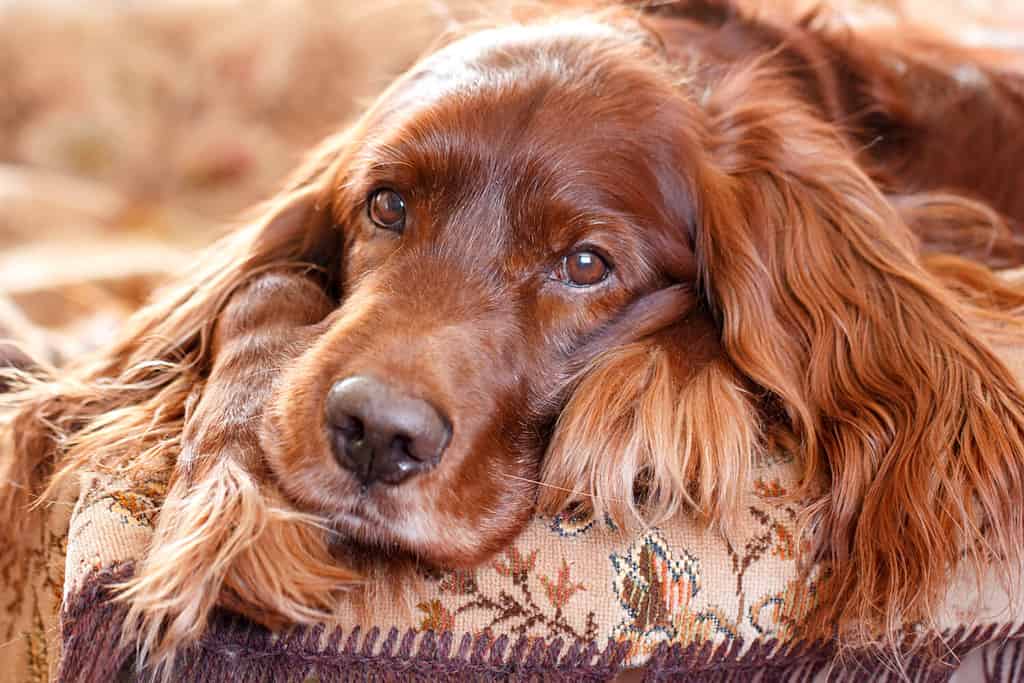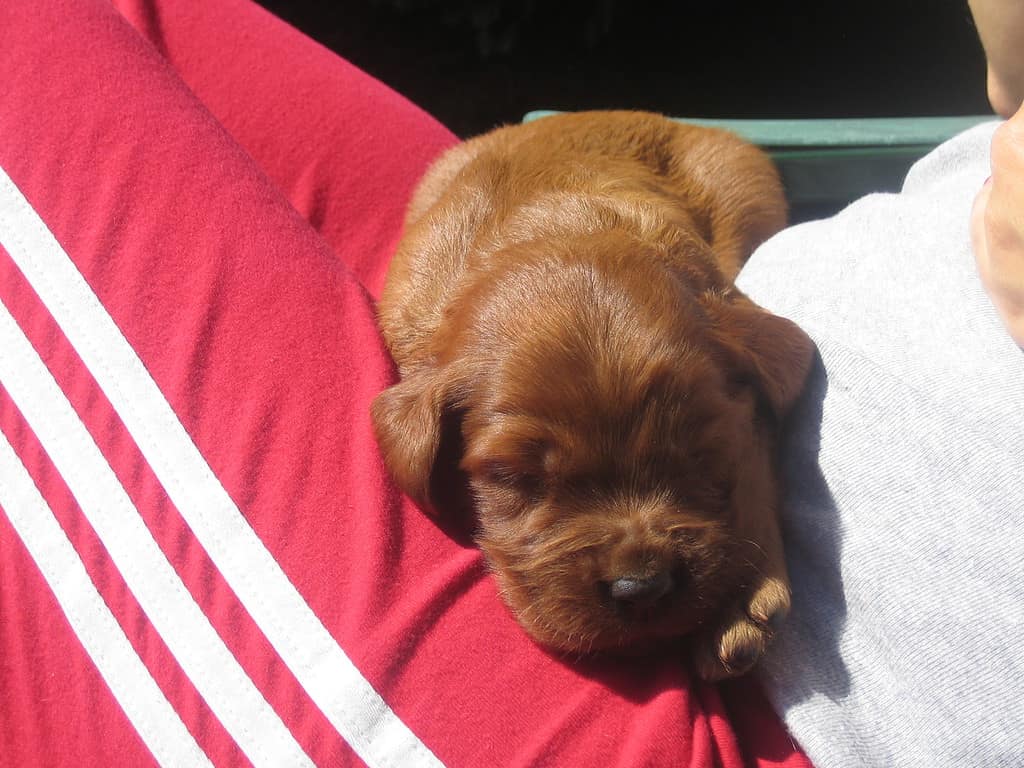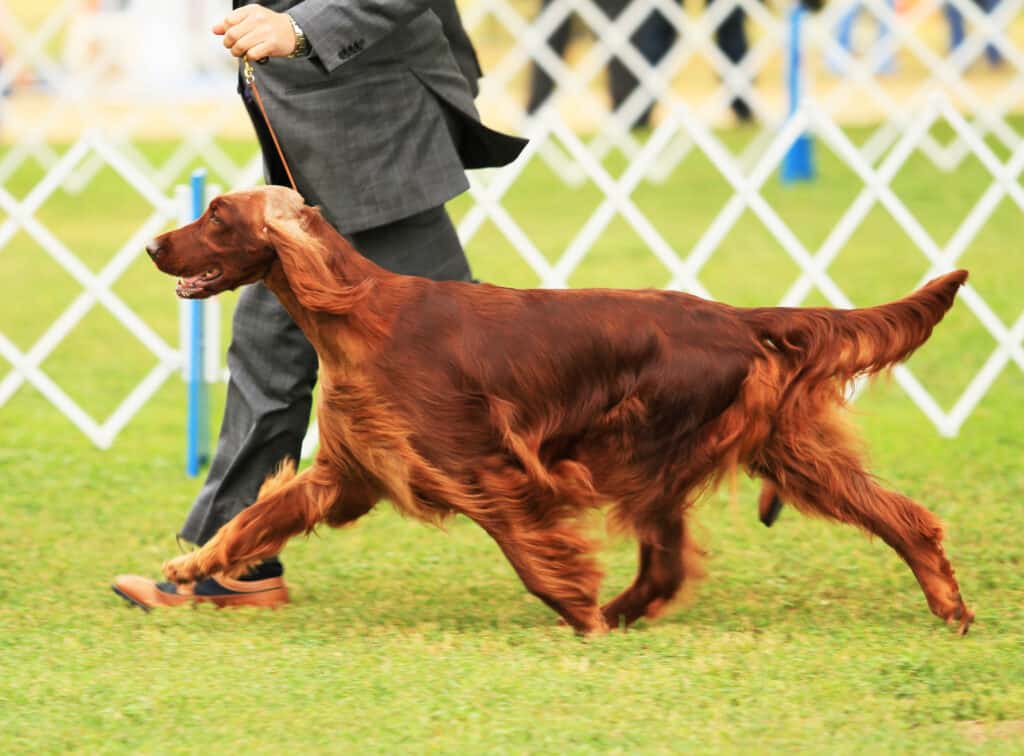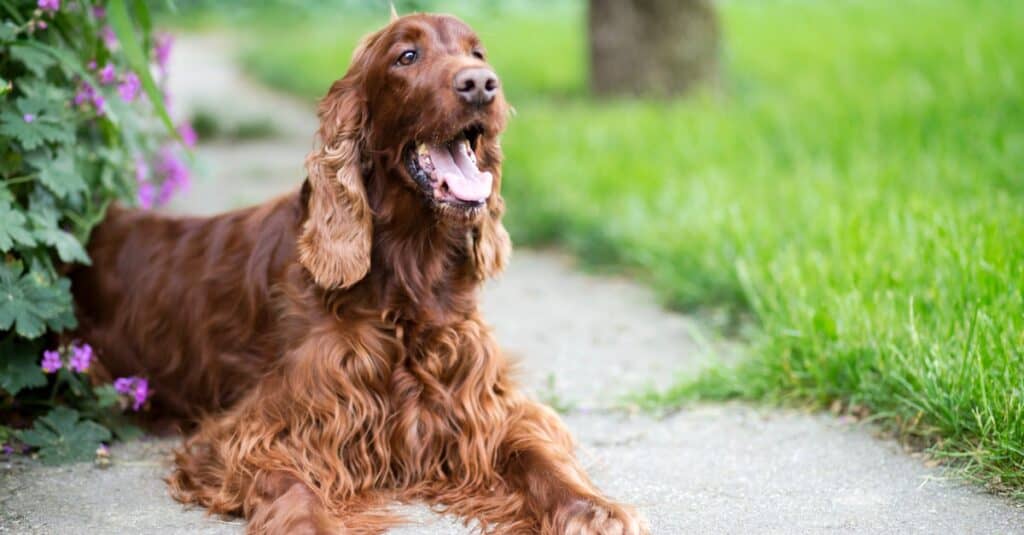Irish setters are beautiful gundogs that hail from Ireland. Although they were initially bred to hunt birds and are still used in hunting today, they also make fantastic companions. These large dogs weigh around 60 to 72 pounds and stand between 25 to 27 inches tall at the shoulder. Their coats are long and silky, and they have feathered ears. Irish setters come in many colors, but red, chestnut, and mahogany are the most common. This breed is intelligent and social. They love to play and are very affectionate towards their owners. So, if you are interested in owning one of these beauties, learn about Irish setter progression to get a feel of how quickly they develop and what to expect.
Irish Setter Growth and Weight Chart by Age
| Age | Male Weight | Female Weight |
|---|---|---|
| Birth | 0.7 to 1 pound | 0.6 to 1 pound |
| 1 Month | 5 to 7 pounds | 3 to 5 pounds |
| 2 Months | 15 pounds | 14 pounds |
| 4 Months | 30 pounds | 28 pounds |
| 6 Months | 40 pounds | 38 pounds |
| 8 Months | 50 pounds | 46 pounds |
| 10 Months | 56 pounds | 52 pounds |
| 12 Months | 60 pounds | 56 pounds |
| 18 Months | 70 to 72 pounds | 58 to 60 pounds |

Irish setters are beautiful gundogs that hail from Ireland. They were initially bred to hunt birds, and while they are still used in hunting today, they also make fantastic companions.
©Sheleh Vadzim/Shutterstock.com
When Will My Irish Setter Stop Growing?
Because of their large size, Irish setter progression is quick, and they usually stop growing between a year and 18 months. However, their growth will start to slow closer to 12 months, so at this stage, your dog is very close to their adult height and weight. Fully-grown Irish setters need between two to three cups of high-quality food per day, divided into two or three separate meals. In addition, water should always be available so your pup doesn’t dehydrate. It is also essential to take your Irish setter to the vet at least twice a year to ensure they are growing normally and everything is in order.

Because of its large size, the Irish setter usually stops growing between a year and 18 months. However, their growth will start to slow closer to 12 months, so at this stage, your dog is very close to their adult height and weight.
©Kseniia Kolesnikova/Shutterstock.com
How Big Will My Irish Setter Be When It’s Fully Grown?
The Irish setter’s progression varies, and their size differs depending on their gender, genetics, and diet; they usually weigh between 58 to 72 pounds. Furthermore, their length ranges from 30 to 35 inches, and they can grow to 25 to 27 inches tall at the shoulder.
When Should My Irish Setter Be Spayed or Neutered?
While many believe that you should neuter and spay your dogs between four and nine months. It depends on their size and maturity. For example, because Irish setters are large dogs, you should wait to have them neutered or spayed until they have reached sexual maturity. This usually happens between 12 to 18 months. Therefore, it is essential to consult with your veterinarian so they can determine when your dog is ready for the surgery. If an Irish setter is spayed or neutered too young, it can make them more susceptible to health conditions like hip dysplasia.
When Should My Irish Setter Be House Broken?
The ideal age to start potty training an Irish setter is between 8 to 12 weeks. However, you can begin training at any age. In fact, the earlier you establish a routine, the better. Take your puppy out as much as possible. It helps if you take them to the same spot every time. Having a routine is the best way to house-train your dog. For example, take them out first thing in the morning, after naps, playtime, eating, and before bed at night. Get to know your puppy and watch them; if they start circling, sniffing, or squatting, take them outside immediately.
When they do relieve themselves outside, praise them with love and cuddles. Also, have phrases like “go potty” or “make” so they know what you expect of them. Repeat this phrase every time you take them outside, and give them a treat or praise when they listen. Sometimes, house-training your Irish setter might be frustrating, but don’t get mad or upset. Instead, be patient and consistent. Stick to your routine; eventually, your pup won’t need supervision anymore.

The ideal age to start potty training an Irish setter is between 8 to 12 weeks. However, you can begin training at any age.
©DragoNika/Shutterstock.com
When Should My Irish Setter Stop Eating Puppy Food?
While many people switch from puppy food to adult food when their dogs reach 12 months old, Irish setters need to stay on puppy food until they are 18 months old. This is because they are still growing between this time and need the nutrients from their good to aid their development. However, once they reach 12 months, they will need more food than before. There are several puppy foods on the market for large breeds, so ensure you choose one of the best brands.
When Will My Irish Setter Start Losing Teeth?
According to the Irish setter’s progression, they start to lose their teeth at about four months old. If their puppy teeth don’t fall out as the adult teeth come in, it can cause damage or infection to the adult teeth. Furthermore, this breed is susceptible to retained teeth, which is when food or hair gets trapped between the puppy and adult teeth. If left untreated, it causes bad breath, painful gums, and adult tooth loss.
When your pup begins teething, you can soothe its discomfort with chew toys like kongs or nylabones. Irish setters are also known for acting out when teething, so expect odd behavior, like chewing on anything and everything.
When Should I Start Training My Irish Setter?
Irish setters are easy to train because of their intelligence and eagerness to please. However, they are also stubborn and independent, so training might require some patience. This breed responds best to positive reinforcement training methods involving praise, rewards, and consistency. Irish setters don’t respond well to anger or abuse; they need a gentle hand. Owners should start training their pups as soon as possible to establish good habits and basic obedience.
Training sessions must be interesting and playful to prevent boredom, as these dogs can lose interest really quickly if things are too repetitive. Owners must also ensure that their Irish setters are socialized from a young age so they feel comfortable in different situations around strangers and other animals. With a lot of patience and consistency, these pups can become obedient and well-behaved companions.
What Cues Should I Teach My Irish Setter First?
When training your Irish setter, start with three to seven-minute sessions, as they are easily distracted. You can lengthen the sessions as time progresses. Start with the basic commands like “heel,” “sit,” “stay,” and “come.”
When Will My Irish Setter Calm Down?
Unfortunately, Irish setters’ progression takes longer when it comes to emotional maturity. So, you will have a puppy-like dog on your hands for a while. These dogs only calm down between two to three years of age. And even then, don’t expect perfect little angels. Irish setters have a lot of energy and, even after they have calmed down, will exhibit rambunctious behavior. You can curb this behavior through mental stimulation, physical activity, and socialization. Furthermore, enrolling your pup in obedience classes or training programs can also help.
Common Health Issues Your Irish Setter Might Experience
Like most breeds, Irish setters are prone to several health issues, including:
- Bloat
- Hip dysplasia
- Hypothyroidism
- Epilepsy
- Progressive Retinal Atrophy
- Osteochondritis Dissecans
Pictures of Irish Setters as Puppies

Owners should start training their pups as soon as possible to establish good habits and basic obedience.
©Francescobrisa / CC BY-SA 3.0 – License

Owners must also ensure that their Irish setters are socialized from a young age so they feel comfortable in different situations around strangers and other animals.
©iStock.com/HannamariaH
Pictures of Adult Irish Setters

Unfortunately, Irish setters are one of the breeds that take the longest to emotionally mature. So, you will have a puppy-like dog on your hands for a while.
©Canden Scales/Shutterstock.com

The Irish setter’s progression varies, and their size differs depending on their gender, genetics, and diet; they usually weigh between 58 to 72 pounds.
©iStock.com/Wavetop
The photo featured at the top of this post is © iStock.com/Wavetop
Thank you for reading! Have some feedback for us? Contact the AZ Animals editorial team.






